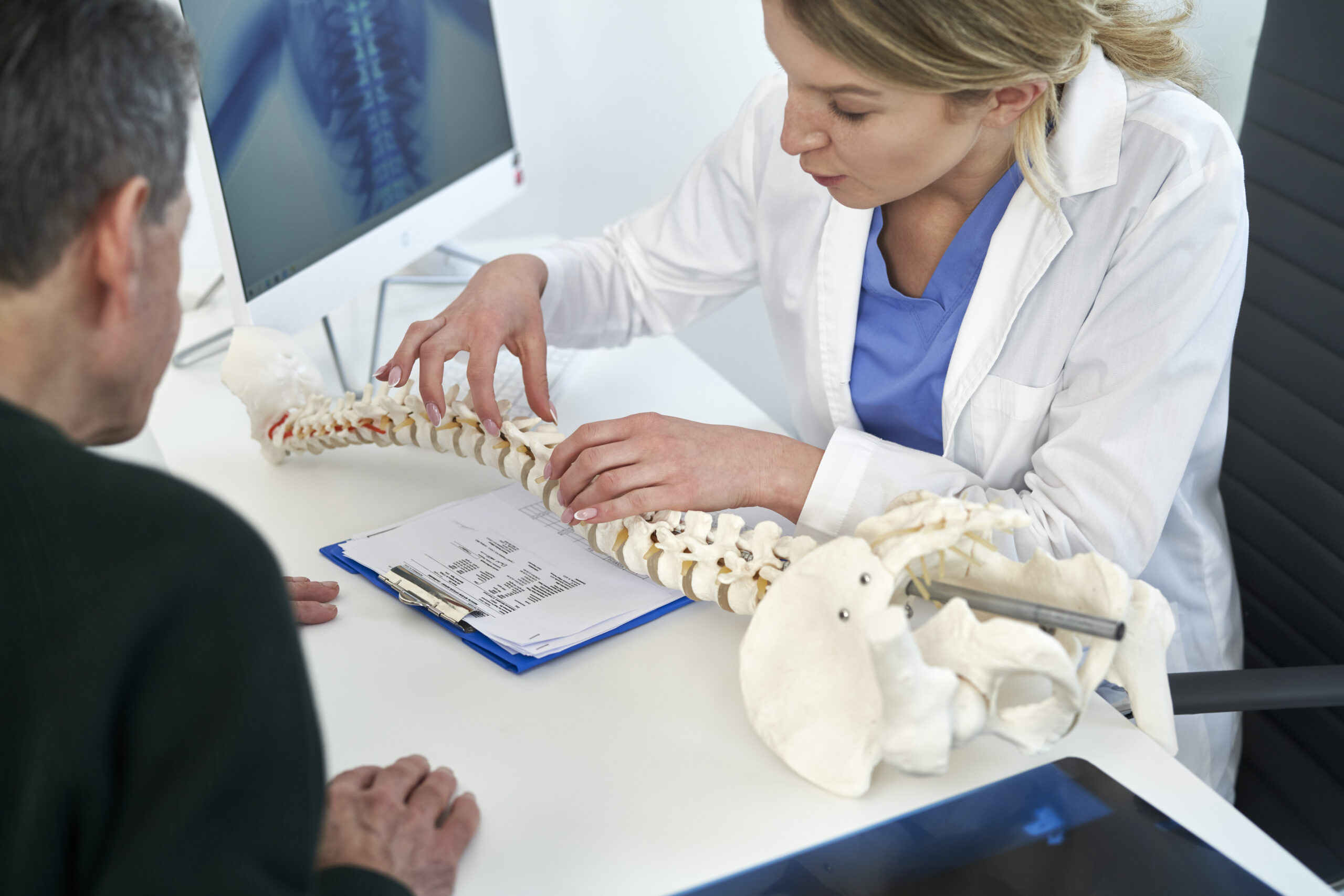Spondylosis refers to the degeneration of the spinal column, often resulting in pain, stiffness, and other debilitating symptoms. As the spine naturally ages, wear and tear can lead to the development of conditions like osteoarthritis and degenerative disc disease. For those suffering from severe symptoms, spondylosis can greatly impact the ability to perform daily tasks or work. Let’s explore whether spondylosis is a disability for which you can file a disability benefits claim.
Understanding Spondylosis and Its Symptoms
Spondylosis primarily affects the spine, leading to the breakdown of cartilage, bones, and discs. It is most common in older adults but can occur at any age due to injury or other factors. The condition can affect different areas of the spine, including the cervical (neck), thoracic (mid-back), and lumbar (lower back) regions. Each of these types of spondylosis presents its own set of challenges.
Cervical spondylosis affects the neck and can cause symptoms such as neck pain, stiffness, and headaches. It may also lead to tingling or numbness in the arms or hands. Lumbar spondylosis, which affects the lower back, can result in pain, difficulty standing or walking, and muscle weakness. Thoracic spondylosis affects the mid-back and is less common but can cause pain and restricted movement.
The symptoms of spondylosis can vary greatly depending on the severity of the condition. Common symptoms include persistent pain, stiffness, limited range of motion, and tingling or numbness in the limbs. These symptoms can significantly impact a person’s ability to perform everyday activities, such as bending, lifting, or even sitting for long periods.
Eligibility for Disability Based on Spondylosis
To qualify for disability benefits through the Social Security Administration (SSA), a medical condition must meet specific criteria outlined in the SSA’s Blue Book, which contains the listing of impairments. Spondylosis may qualify under the broader category of musculoskeletal disorders if it is severe enough to limit a person’s ability to work.
The SSA evaluates spondylosis based on the extent to which the condition limits an individual’s ability to perform basic work-related activities. Factors such as pain, stiffness, range of motion, and the impact on strength and dexterity are considered. If the severity of the condition impedes a person’s ability to maintain employment, they may be eligible for disability benefits.
Spondylosis can qualify for benefits if the symptoms are debilitating and cause significant functional impairment. For instance, if the condition leads to chronic pain or loss of motion that prevents the individual from performing tasks such as sitting, standing, lifting, or walking, they may meet the SSA’s criteria for disability.
Medical Documentation for a Spondylosis Claim
When applying for disability benefits, thorough medical documentation is crucial to demonstrate the severity of your spondylosis and its impact on your ability to work. The SSA requires a comprehensive history of your condition, including details of tests, imaging studies, and ongoing treatments.
Imaging studies like MRIs or CT scans are essential in diagnosing spondylosis and showing the extent of spinal degeneration. These scans can help illustrate the level of disc damage, the presence of bone spurs, and other structural changes that may be causing symptoms. These tests provide objective evidence of the condition’s severity, which is vital for supporting your claim.
In addition to imaging studies, a detailed treatment history is important. This includes records of doctor visits, medications prescribed, physical therapy, and any surgeries or other treatments you’ve undergone. The SSA looks for a consistent pattern of care to demonstrate that the condition is ongoing and severe.
Statements from your physician substantiate your disability claim. A doctor’s statement outlining the limitations imposed by spondylosis, the treatments tried, and the expected prognosis can provide valuable support for your application. These statements can help show the SSA that your condition is severe enough to prevent you from performing daily tasks or working.
Proving Functional Impairments
A key part of proving disability due to spondylosis is demonstrating how the condition limits your ability to perform essential work-related activities. The SSA evaluates functional impairments by looking at the specific tasks that are affected by your condition.
For example, spondylosis may make it difficult to perform physical activities such as lifting, bending, or standing for extended periods. It may also interfere with the ability to sit for long hours or concentrate on tasks due to pain or discomfort. In severe cases, it can impair mobility and cause significant difficulty in walking, climbing stairs, or even carrying out basic household chores.
Functional capacity evaluations (FCEs) are often used to assess a person’s ability to perform specific tasks. These evaluations are conducted by healthcare professionals and measure how well an individual can perform physical tasks. FCEs can be a crucial part of your claim as they provide objective data regarding your limitations.
The Disability Application Process
Applying for disability benefits based on spondylosis involves several key steps. First, you will need to gather medical evidence and documentation to support your claim. This includes medical records, test results, treatment history, and physician statements, all of which should provide a clear picture of how spondylosis impacts your daily life.
Once your documentation is in order, you can begin the application process through the SSA. This can be done online, over the phone, or in person at your local SSA office. The SSA will review your application and may request additional information or testing to determine the severity of your condition.
Unfortunately, many disability claims are initially denied. However, a denial is not the end of the road. You have the right to appeal the decision, and the process includes several stages, including a hearing before an administrative law judge. It’s important to address any deficiencies in the original application and to provide additional evidence if necessary.
Understanding the Impact of Spondylosis on Quality of Life
Spondylosis can profoundly affect an individual’s quality of life, even outside of the workplace. While many people are aware of the connection between disability and work-related activities, it’s equally important to understand how this condition can impact day-to-day living. The chronic pain and stiffness associated with spondylosis can interfere with routine tasks such as driving, housework, shopping, and personal care. As the condition progresses, the limitations can become more pronounced, making it difficult to engage in hobbies, socialize, or perform even simple chores without assistance.
For instance, cervical spondylosis can make turning the head to check for traffic while driving or simply looking over one’s shoulder an uncomfortable and hazardous task. Lumbar spondylosis can make activities like bending down to pick up objects or walking for any extended period unbearable. These limitations are not only physically restrictive but can also take a mental and emotional toll on those affected, leading to feelings of frustration, depression, or anxiety.
Spondylosis and Comorbid Conditions
In many cases, individuals with spondylosis also experience comorbid conditions that can further complicate their eligibility for disability benefits. Comorbid conditions are other medical issues that co-exist alongside the primary condition, such as spondylosis, and they can exacerbate symptoms or make it even more difficult for an individual to work or care for themselves.
For example, someone with cervical or lumbar spondylosis may also suffer from conditions like spinal stenosis, herniated discs, or even rheumatoid arthritis, all of which can intensify pain and mobility issues. Additionally, chronic pain from spondylosis can lead to other physical or mental health issues, including depression, anxiety, sleep disturbances, and reduced overall strength or endurance.
The presence of comorbid conditions must be documented in a disability claim, as they can provide additional evidence of functional limitations. The SSA recognizes the cumulative effect of multiple conditions on a person’s ability to work. If spondylosis is accompanied by conditions that further impair mobility or cognitive function, the likelihood of meeting the SSA’s criteria for disability increases.
During the disability application process, it is crucial to include all relevant comorbidities and explain how they interact with your primary condition. Comprehensive medical documentation showing how spondylosis and other conditions collectively limit your ability to perform tasks can strengthen your claim and ensure that the full extent of your disability is acknowledged.
Contact Benefits Claim Advice to Learn Whether Spondylosis Is a Disability For Which You Can File a Benefits Claim
Having professional guidance can significantly increase your chances of success when filing a benefits claim. Benefits Claim Advice assists people with musculoskeletal conditions, including spondylosis, in obtaining the disability benefits they deserve. Our team can help you gather the necessary documentation, complete your application, and represent you throughout the appeals process. Contact us to get the support and expertise needed to maximize your chances of success in securing disability benefits and learn whether spondylosis is a disability for which you can file a benefits claim.


